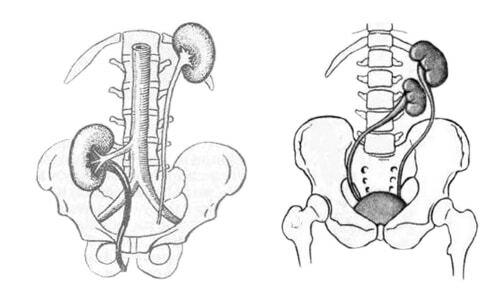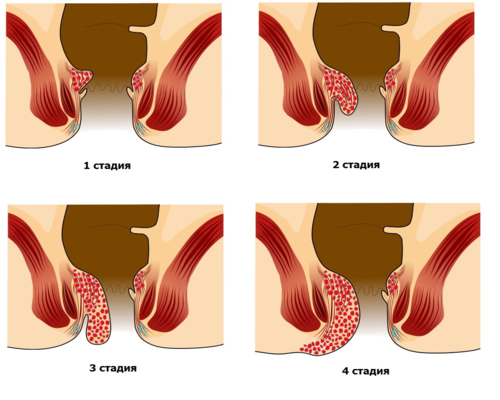If the kidney from birth is not positioned correctly, for example, it moves to the pelvis, thorax, sacroiliaccavity or is too low, then a similar condition is called kidney dystopia. This condition is congenital in nature and is often accompanied by impaired urination and pain symptoms.

Causes of renal anomaly
As a result of long-term observations, scientists came to the conclusion that kidney dystopia is an exclusively congenital anomaly of genetic origin. This abnormality is based on disturbances in the embryonic movement of the kidney or its rotation( slightly rotated arrangement) in place of the traditional arrangement.
Warning! Obstetric experience or type of labor( traditional or caesarean section) does not play any role in the etiology of such anomaly.
Initially, the kidneys are placed in the fetal cavity in the low-dose cavity, then during the intrauterine development they gradually move to the lumbar region in order to occupy anatomically correct location. But under the influence of pathological conditions, a similar renal anomaly is formed. There are a lot of unfavorable factors provoking an abnormal location of the kidney:
- Abuse of pregnant alcohol;
- Nicotine dependence;
- Various substances of chemical origin;
- Drug use;
- Psychological trauma and severe stress during pregnancy;
- Toxic effects of various components in products;
- Heredity due to genetic predisposition.
Kinds of renal dystopia
There is a bilateral or one-sided abnormal arrangement of the kidneys. If one or both organs are placed on the opposite side, then a cross dystopia of the kidney is diagnosed, in which fusion or fusion of the kidneys often occurs. If the kidney is placed incorrectly, but in its half of the body, then homolateral dystopia is diagnosed.
According to statistics, most often in medical practice, there is a right-sided dystopia of the lumbar localization, which is characterized by a displacement of the right kidney slightly below the anatomical norm, with the organ locating forward and easily probed in the hypochondrium. This form of renal dystopia is often confused with a tumor-like formation during a primary examination.
According to the level at which the abnormal kidney is fixed, the lumbar, iliac or pelvic dystopy is classified. With pelvic dystopic localization, the abnormally located kidney is often perceived as a source of inflammation in the organs of the genitourinary system. As for the iliac form of the anomaly, it is confused with abdominal neoplasms. There is also a thoracic form of dystopia, which is the migration of the organ to the thoracic region, which is often identified with an abscess, tumor, or tumor.

Clinical picture of anomaly
Symptomatic picture of abnormal location of the kidney depends on the location of the organ:
- Pelvic kidney dystopia usually manifests itself as a painful symptom in the intestinal zone. Such a dystopic form is about 20% of all renal dystopia. If the abnormal kidney compresses the bowel or bladder, then the patient begins to worry about constipation or a frequent desire to empty the bladder. Such anomalous form is quite rare, but it is considered dangerous for women of childbearing age, because it can adversely affect the course of pregnancy, causing complications or increased toxic symptoms;
- Dystopia of lumbar localization is often characterized by asymptomatic development and course, although occasionally muffled pain in the lower back may occur. This form is more common than the others and is about 67% of cases;
- Patients with iliac anomaly, accounting for about 12% of cases, also note pain syndrome in the abdominal wall from the side. Pain symptomatology is caused by pressure on nearby organs or nerve endings. In a similar pattern, other disorders such as urinary difficulties, constipation, gastric spasms or flatulence, etc., also develop;
- Breast right-sided dystopia of the kidney is often accompanied by chest pain, especially after eating;
- The dystopia of the thoracic species is characterized by a simultaneous development with a hernial process in the diaphragm;
- In the case of cross dystopia, renal dysfunction occurs, often vascular clench occurs against the background of this anomaly, causing renal blood flow to break down and already in childhood develops stable hypertension.
Kidney anomalies of a dystopic nature are characterized by low resistance to pathological processes, which is due to the presence of many additional elements in the vascular system, disorders of the urinary flow, etc. Often against the background of dystopia, pathologies such as tuberculosis, hydronephrosis, nephrolythiasis and similar conditions develop.
Diagnostic process
If the localization of an abnormally located organ is characterized by a lumbar or iliac region, it can be probed through the peritoneum. Dystopia of the pelvic kidney can be found in the rectal finger examination of a man, when probed, it is a sedentary solid formation located near the rectum.
In ultrasound examination, a kidney can be found at an anatomically correct location. Dystopia of the thoracic nature can be detected during the prophylactic fluorography study or in the case of the chest X-ray. In these cases, the dystopic kidney may appear as a rounded shadow over the diaphragm area.
It may happen that a patient with an abnormal kidney will need surgical treatment somewhere in the abdominal or thoracic area. Such operations often lead to damage to the abnormal located organ, which are eliminated by suturing vessels. If the body can not be saved, nephrectomy is performed.
Specialists for the detection of renal dystopia use imaging hardware:
- Renal ultrasound;
- Urography of excretory or retrograde character - this study helps to accurately determine the rotational degree, abnormal location and limitation of renal mobility;
- Scintigraphic study or radioisotope renography;
- MSCT or multispiral computed tomography;
- Magnetic resonance imaging;
- Angiography of the kidneys will determine the number of departures of the arteries of the kidney from the aortic trunk.
In addition to the hardware methods of research, traditional laboratory procedures are used - urine, blood tests, etc.
Approach to therapy
Therapeutic tactics are by no means independent of the abnormal localization of the organ or the degree of its displacement. The basic factor in the choice of treatment is the condition and functioning of the abnormal organ. If the kidney dystopy is accompanied by pathological processes of inflammatory origin, then antibiotic therapy is indicated, based on the use of drugs like Ciprofloxacin or Furmag. Pain symptoms can be alleviated by taking painkillers( Spazgan, Spazmalgon, Baralgin, etc.).These drugs, in addition to the analgesic effect, also provide an anti-inflammatory effect on the abnormal kidney and nearby systems.
Conservative therapy is also in preventive measures against stone formation or is aimed at their removal from the organs of the genitourinary system.
In medical practice, there have been cases when doctors, because of negligence, removed a single kidney from the patient. Statistics confirm that in the presence of dystopia there is a high proportion of probability, the absence of a second kidney.
If the pathology is complicated by the pyelonephritic process, then the treatment is based on the intake of antibiotics, nitrofurans, sulfonamides, and also drugs that favorably affect the kidney blood flow. Sometimes, with conservative therapy, there is a need for surgical removal of calculi from the kidney during nephrolithotripsy, nephrolithotomy and other types of operations.
Operative treatment is considered justified only if renal dystopia leads to a violation of the circulation of the wrongly positioned organ or to mechanical influence on organs located next to the abnormal kidney. The principle of surgical operation is based on the removal of the kidney or it is moved and fixed in the correct place from the point of view of anatomy. Nephrectomy or removal of the organ is usually resorted to in the case of complete necrosis of the kidney tissues. Before the operation, specialists carefully study the second kidney, evaluate its functional abilities.
If a patient has a dystopia, then it is registered for urological registration. Further predictions are due to the course of the anomaly, the emergence of characteristic complications such as pyelonephritis, hydronephrosis, various neoplasms, etc.
How to live with the dystopia
Patients with dystopic renal anomalies are shown dietary nutrition, regardless of the nature of the therapeutic tactics. The diet requires a complete rejection of smoked products, alcoholic products, fried foods, spices, etc. And such a diet is life-long.
In addition, you must be careful of the pathologies of colds and hypothermia. Doctors especially distinguish angina, the causative agent of which is hemolytic streptococcus, which negatively affects renal function. It is extremely important to observe the drinking regime and not to abuse mineral water in order to avoid the formation of concrements.
Prevention measures
Because renal dystopia is characterized by an innate etiology, preventive measures should be taken before the appearance of the child. It is necessary to undergo a medical genetic consultation to exclude the probability of such an anomaly in the future offspring.
During pregnancy, you should not drink alcohol, smoke, or eat irrationally. It is necessary to avoid radiation or chemical exposure in every possible way, as these substances can lead to the appearance of various pathologies in the fetus.



